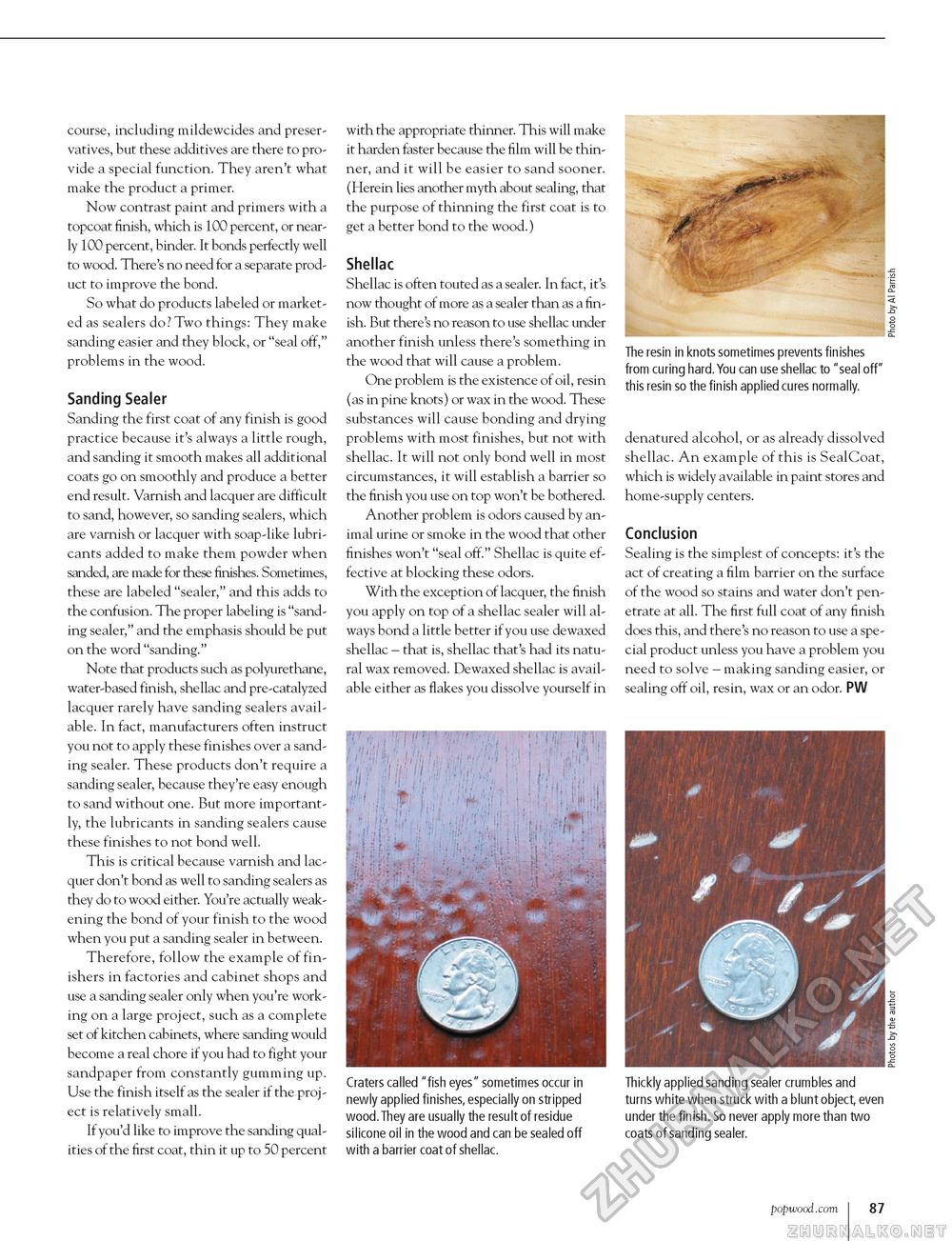Popular Woodworking 2004-06 № 141, страница 89
course, including mildewcides and preservatives, but these additives are there to provide a special function. They aren't what make the product a primer. Now contrast paint and primers with a topcoat finish, which is 100 percent, or nearly 100 percent, binder. It bonds perfectly well to wood. There's no need for a separate product to improve the bond. So what do products labeled or marketed as sealers do? Two things: They make sanding easier and they block, or "seal off," problems in the wood. Sanding Sealer Sanding the first coat of any finish is good practice because it's always a little rough, and sanding it smooth makes all additional coats go on smoothly and produce a better end result. Varnish and lacquer are difficult to sand, however, so sanding sealers, which are varnish or lacquer with soap-like lubricants added to make them powder when sanded, are made for these finishes. Sometimes, these are labeled "sealer," and this adds to the confusion. The proper labeling is "sanding sealer," and the emphasis should be put on the word "sanding." Note that products such as polyurethane, water-based finish, shellac and pre-catalyzed lacquer rarely have sanding sealers available. In fact, manufacturers often instruct you not to apply these finishes over a sanding sealer. These products don't require a sanding sealer, because they're easy enough to sand without one. But more importantly, the lubricants in sanding sealers cause these finishes to not bond well. This is critical because varnish and lacquer don't bond as well to sanding sealers as they do to wood either. You're actually weakening the bond of your finish to the wood when you put a sanding sealer in between. Therefore, follow the example of finishers in factories and cabinet shops and use a sanding sealer only when you're working on a large project, such as a complete set of kitchen cabinets, where sanding would become a real chore if you had to fight your sandpaper from constantly gumming up. Use the finish itself as the sealer if the project is relatively small. If you'd like to improve the sanding qualities of the first coat, thin it up to 50 percent with the appropriate thinner. This will make it harden faster because the film will be thinner, and it will be easier to sand sooner. (Herein lies another myth about sealing, that the purpose of thinning the first coat is to get a better bond to the wood.) Shellac Shellac is often touted as a sealer. In fact, it's now thought of more as a sealer than as a finish. But there's no reason to use shellac under another finish unless there's something in the wood that will cause a problem. One problem is the existence of oil, resin (as in pine knots) or wax in the wood. These substances will cause bonding and drying problems with most finishes, but not with shellac. It will not only bond well in most circumstances, it will establish a barrier so the finish you use on top won't be bothered. Another problem is odors caused by animal urine or smoke in the wood that other finishes won't "seal off." Shellac is quite effective at blocking these odors. With the exception of lacquer, the finish you apply on top of a shellac sealer will always bond a little better if you use dewaxed shellac - that is, shellac that's had its natural wax removed. Dewaxed shellac is available either as flakes you dissolve yourself in Craters called "fish eyes" sometimes occur in newly applied finishes, especially on stripped wood.They are usually the result of residue silicone oil in the wood and can be sealed off with a barrier coat of shellac. The resin in knots sometimes prevents finishes from curing hard.You can use shellac to "seal off" this resin so the finish applied cures normally. denatured alcohol, or as already dissolved shellac. An example of this is SealCoat, which is widely available in paint stores and home-supply centers. Conclusion Sealing is the simplest of concepts: it's the act of creating a film barrier on the surface of the wood so stains and water don't penetrate at all. The first full coat of any finish does this, and there's no reason to use a special product unless you have a problem you need to solve - making sanding easier, or sealing off oil, resin, wax or an odor. PW Thickly applied sanding sealer crumbles and turns white when struck with a blunt object, even under the finish. So never apply more than two coats of sanding sealer. popwood.com 87 |








